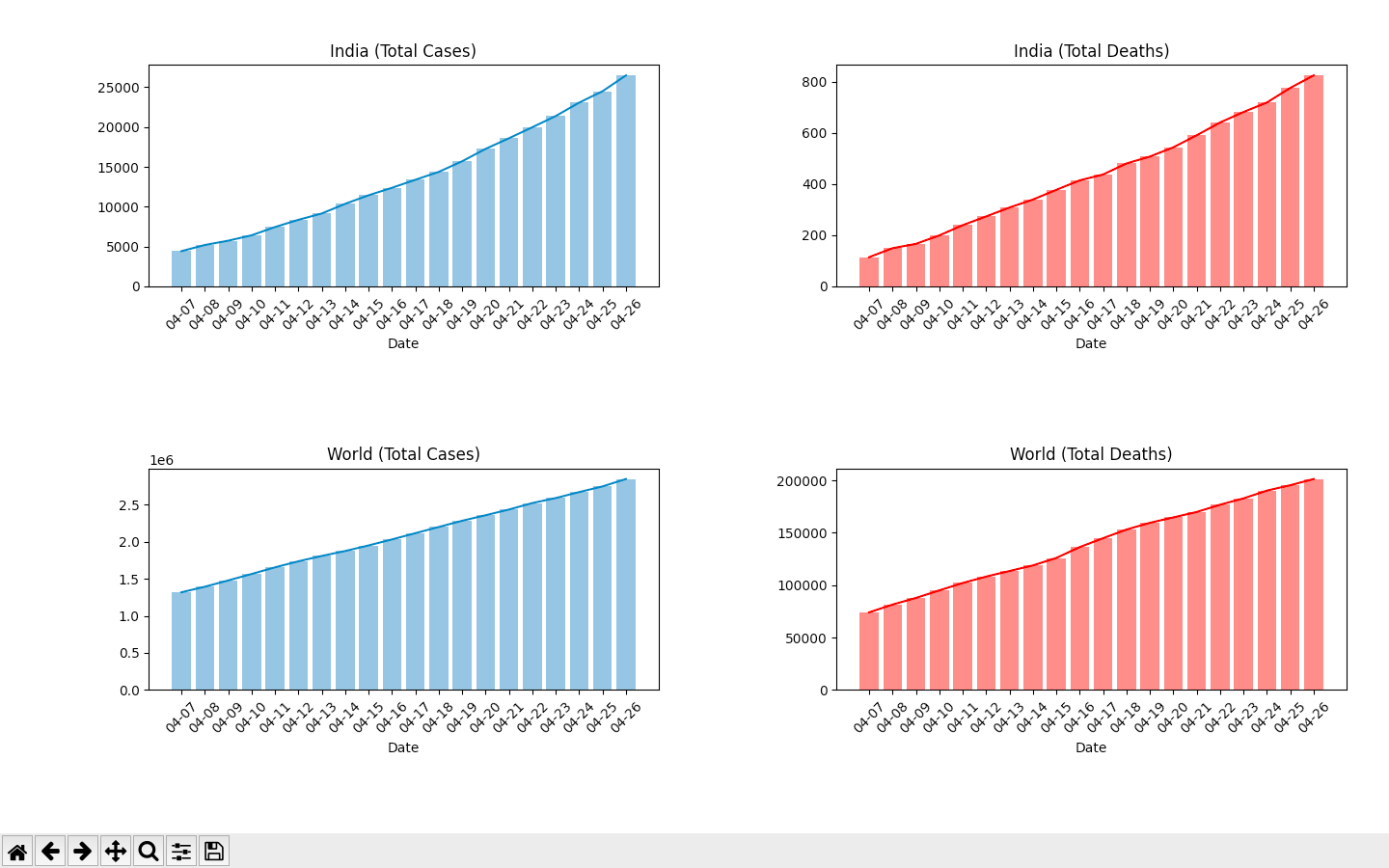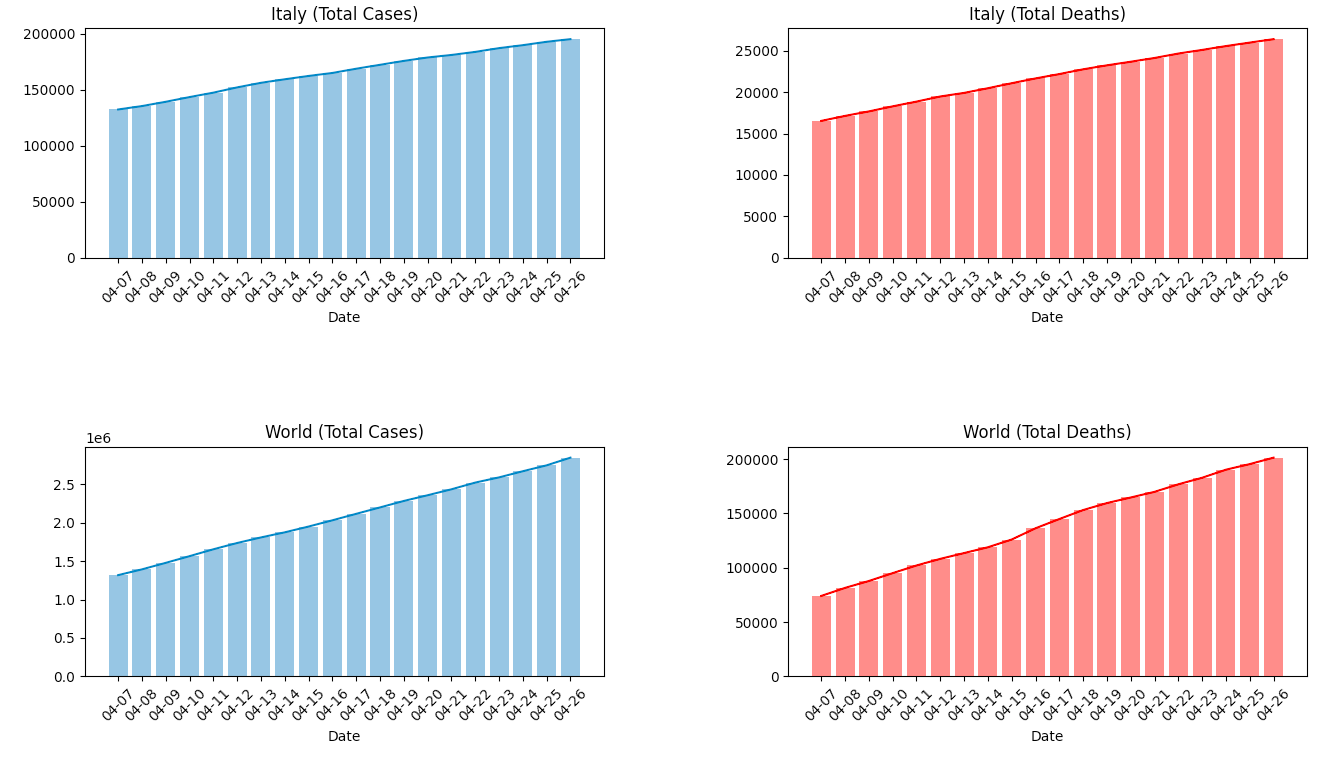En este artículo, recopilaremos la información actualizada más reciente sobre los casos de coronavirus en todo el mundo y en un país en particular. Trazaremos gráficos para visualizar el crecimiento del número total de casos y el total de muertes durante los últimos 20 días. Los datos más recientes se obtienen de Our World in Data .
Módulos Python requeridos
- requests:
la biblioteca de requests se utiliza para realizar requests HTTP en Python.pip install requests
- matplotlib:
matplotlib es una biblioteca completa para crear varios tipos de gráficos y visualizaciones interactivas en Python.pip install matplotlib
Explicación:
Los datos extraídos del sitio web (mediante requests) se convierten al formato similar a csv. Luego, estos datos se filtran para obtener las estadísticas requeridas de los últimos 20 días y se trazan las visualizaciones (usando matplotlib).
A continuación se muestra la implementación.
from matplotlib import pyplot as plt
import requests
# function to plot data for country
# and world
def Plot(country):
# getting request from the url
req = requests.get('https://covid.ourworldindata.org / data / ecdc / full_data.csv')
req.raise_for_status()
# converting to text and splitting
# the rows of the csv data
cf = req.text.split('\n')
# converting to 2 dimensional list
for i in range(len(cf)):
cf[i]= cf[i].split(', ')
dates =[]
total =[]
total_w =[]
deaths =[]
deaths_w =[]
l =[]
f = 0
for i in range(len(cf)-1):
l = cf[i]
c = l[1]
# filtering data for a particular country
if c == country:
f = 1
# getting the dates, total cases and
# deaths for the particular country
dates.append(l[0][5:])
total.append(int(l[4]))
deaths.append(int(l[5]))
# filtering data for the world
if c =='World':
# getting total cases and deaths for
# the world
total_w.append(int(l[4]))
deaths_w.append(int(l[5]))
if f == 0:
print("Invalid country name.")
return
# Plotting country data
total_ax = plt.subplot(2, 2, 1)
total_ax.set_title(country+' (Total Cases)')
# plotting the curve for total cases
total_ax.plot(dates[-20:], total[-20:])
# plotting the bars for total cases
total_ax.bar(dates[-20:], total[-20:], alpha = 0.5)
total_ax.set_xlabel("Date")
plt.xticks(rotation = 45)
death_ax = plt.subplot(2, 2, 2)
death_ax.set_title(country+' (Total Deaths)')
# plotting the curve for deaths
death_ax.plot(dates[-20:], deaths[-20:], color ='red')
# plotting the bars for deaths
death_ax.bar(dates[-20:], deaths[-20:], color ='red', alpha = 0.5)
death_ax.set_xlabel("Date")
plt.xticks(rotation = 45)
# Plotting world data
total_w_ax = plt.subplot(2, 2, 3)
total_w_ax.set_title('World (Total Cases)')
# plotting the curve for total cases
total_w_ax.plot(dates[-20:], total_w[-20:])
# plotting the bar for total cases
total_w_ax.bar(dates[-20:], total_w[-20:], alpha = 0.5)
total_w_ax.set_xlabel("Date")
plt.xticks(rotation = 45)
death_w_ax = plt.subplot(2, 2, 4)
death_w_ax.set_title('World (Total Deaths)')
# plotting the curve for deaths
death_w_ax.plot(dates[-20:], deaths_w[-20:], color ='red')
# plotting the curve for deaths
death_w_ax.bar(dates[-20:], deaths_w[-20:], color ='red', alpha = 0.5)
death_w_ax.set_xlabel("Date")
plt.xticks(rotation = 45)
plt.tight_layout()
print("Enter country name...")
country = input().title()
Plot(country)
plt.show()
Aporte :
Enter country name... India
Producción :

Aporte :
Enter country name... Italy
Producción :

Publicación traducida automáticamente
Artículo escrito por cosine1509 y traducido por Barcelona Geeks. The original can be accessed here. Licence: CCBY-SA